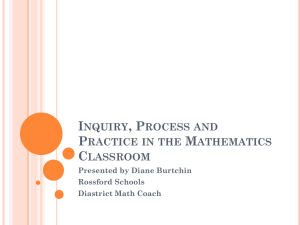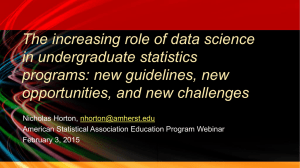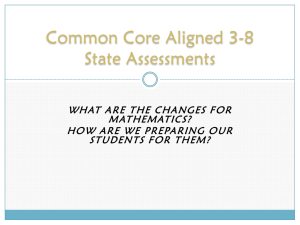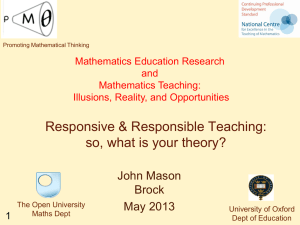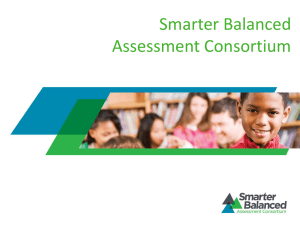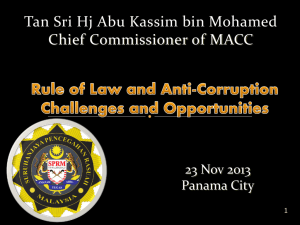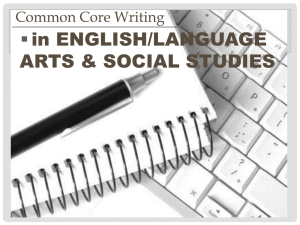Focus on the STEM and the Core
advertisement
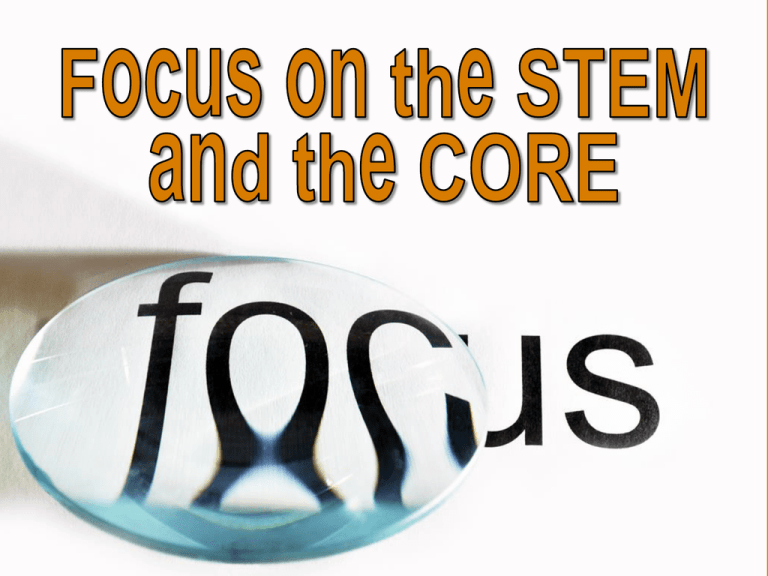
“We live in a time of vast changes that include accelerating globalization, mounting quantities of information, the dominating influence of science and technology, and the clash of civilizations. Those changes call for new ways of learning and thinking in school, business, and the professions.” -Howard Gardner Five Minds for the Future (2007) http://www.corestandards.org Phase 1 (2011-2012) Phase 2 (2012-2013) Full Implementation Grade K Phase 3 (2013-2014) Full Implementation Begin Implementation of Literacy Standards in ALL Content Areas for Grades 6-12 Grades K-1 Full Implementation of Literacy Standards in ALL Content Areas for Grades 6-12 Full Implementation Grades K-2 Phase 4 (2014-2015) Full Implementation Grades K-12 Implementation of a Blended Curriculum (CCSS and Supplemental NGSSS PARCC Assessments Aligned to FCAT 2.0 and Aligned to CCSS EOCs) for Grades 3-12 Begin Implementation of Rich and Complex Text and Informational Text for Continue Implementation Grades K-12 of Rich and Complex Text and Informational Text for Grades K-12 Continue Implementation of Rich and Complex Text and Informational Text for Grades K-12 http://www.fldoe.org/bii/pdf/CCSS-ImplementationTimeline.pdf 3 “The Standards for Mathematical Practice are unique in that they describe how teachers need to teach to ensure their students become mathematically proficient. We were purposeful in calling them standards because then they won’t be ignored.” - Bill McCallum Develops dispositions and habits of mind “Characteristic of an educated person” • Precision in thought • Precision in the use of language and terms • Precision of argument • Sense making happens through conversations -Jason Zimba http://youtu.be/9pKcO9E4Flw 5 1. Make sense of problems and persevere in solving them 2. Reason abstractly and quantitatively 3. Construct viable arguments and critique the reasoning of others 4. Model with mathematics 5. Use appropriate tools strategically 6. Attend to precision 7. Look for and make use of structure 8. Look for and express regularity in repeated reasoning 6 Performance Task: Open you Common Core Book to the Standards for Mathematical Practice Read through the Practices Think of a few questions that you might use to help students develop these habits of mind. 1. Make sense of problems and persevere in solving them What is the problem asking? How would you describe the problem? How would you describe what you are trying to find? What information is given in the problem? What steps have your already tried? What might you change? What is another strategy that you might try? How might you use one of your previous problems to help you? How else might you organize… represent.. show…? How will you know if your answer makes sense? 2. Reason abstractly and quantitatively What do the numbers used in the problem represent? What is the relationship of the quantities? What is the relationship between ___ and ____? How is ___ related to ___? What properties might you use to find a solution? How do you know your answer is reasonable? 3. Construct viable arguments and critique the reasoning of others How did you decide what the problem was asking you to find? How did you test whether your approach worked? What other methods did you try? Did they work? Why or why not? What can you tell us about a different method? How does your representation support your work? What were you considering when …? How can you be sure that …? What evidences would support your solution? 4. Model with mathematics What model could you construct to represent the problem? What are some ways to represent the quantities? How would it help to create a diagram, graph, table …? What are some ways to visually represent …? What formula might apply in this situation? How would you change your model if….? 5. Use appropriate tools strategically You’ve heard of smart computers? Well, these are graduated cylinders. What could you use to help solve the problem? What mathematical tools can be used to visualize and represent the situation? What can using a ____ show us that ____ may not? In which situation might it be helpful to use … a graph ..., number line…, rule…, diagram …, calculator …, manipulative? In what situations might it be more informative or helpful to use...? Why did you decide to use___ ? 6. Attend to Precision How are you showing the meaning of the quantities? What symbols or mathematical notations are important in this problem? What mathematical language…, definitions…, properties can you use to explain … ? How can you mathematical terms (vocabulary) in your explanation? What does that mean? 7.Look for and make sense of structure What do you notice when…? What patterns do you find in…? How does this relate to … ? In what ways does this problem connect to other mathematical concepts? What rule did you use to solve this problem? How is this like… ? Explain how this strategy works in other situations? What do you notice about…? What is happening in this situation? What would happen if… ? What mathematical rule applies to this situation? What predictions or generalizations can this pattern support? What mathematical consistencies do you notice? Standard or Benchmark Aligned to Course Description • Guides the development of the lesson beginning with the desired outcome Learning Goals Engaging Lesson Formative, Interim, and/or Summative Assessments • Includes appropriate and meaningful activities that engage students in the learning process, address common misconceptions, and incorporate higher-order thinking skills • Describes what students should know and be able to do • Includes essential questions and • Rubrics to define levels of knowledge acquisition • Provides multiple sources of student data to guide decisions about adjusting instruction and/or providing interventions 25 Course Requirements and Standards “Chunks” or Big Ideas Major Learning Goals Progression Scales for Major Learning Goals Progress Monitoring Assessments 26 Follow precisely a multistep procedure when carrying out experiments, taking measurements, or performing technical tasks. LACC.68.RST.3.7 Integrate quantitative or technical information expressed in words in a text with a version of that information expressed visually (e.g., in a flowchart, diagram, model, graph, or table). LACC.68.WHST.1.1 Write arguments focused on discipline-specific content. LACC.68.WHST.1.1b Support claim(s) with logical reasoning and relevant, accurate data and evidence that demonstrate an understanding of the topic or text, using credible sources. LACC.68.RST.1.3 MACC.7.G.2.6 MACC.7.EE.2.3 Solve real-world and mathematical problems involving area, volume and surface area of two- and three-dimensional objects composed of triangles, quadrilaterals, polygons, cubes, and right prisms. Solve multi-step real-life and mathematical problems posed with positive and negative rational numbers in any form (whole numbers, fractions, and decimals), using tools strategically. Apply properties of operations to calculate with numbers in any form; convert between forms as appropriate; and assess the reasonableness of answers using mental computation and estimation strategies. MACC.7.EE.2.4 Use variables to represent quantities in a real-world or mathematical problem, and construct simple equations and inequalities to solve problems by reasoning about the quantities. MACC.7.EE.2.4a Solve word problems leading to equations of the form px + q = r and p(x + q) = r, where p, q, and r are specific rational numbers. Solve equations of these forms fluently. Compare an algebraic solution to an arithmetic solution, identifying the sequence of the operations used in each approach. For example, The perimeter of a rectangle is 54 cm. Its length is 6 cm. What is its width? MACC.8.G.3 Solve real-world and mathematical problems involving volume of cylinders, cones and spheres. Know the formulas for the volume of cones, cylinders, and spheres and use them to solve real-world and mathematical problems. Describe qualitatively the functional relationship between two quantities by analyzing a graph (e.g., where the function is increasing or decreasing, linear or nonlinear). Sketch a graph that exhibits the qualitative features of a function that has been described verbally. MACC.8.G.3.9 MACC.8.F.2.5 SC.8.N.1.1 Define a problem from the eighth grade curriculum using appropriate reference materials to support scientific understanding, plan and carry out scientific investigations of various types, such as systematic observations or experiments, identify variables, collect and organize data, interpret data in charts, tables, and graphics, analyze information, make predictions, and defend conclusions. SC.8.P.8.2 Differentiate between weight and mass recognizing that weight is the amount of gravitational pull on an object and is distinct from, though proportional to, mass. SC.8.P.8.3 Explore and describe the densities of various materials through measurement of their masses and volumes. Kent Treadgold 7th grade Density https://www.teachingchannel.org/videos/teaching-density?fd=1# http://youtu.be/iHFHzjjHNsg Task: As you view the video, Making Sense of Density, record where you see the Standards for Mathematical Practice being infused. Florida Common Core – http://www.fldoe.org/schools/ccc.a sp – http://www.fldoe.org/schools/Blast Off.asp Common Core State Standards for Mathematics – http://www.corestandards.org CPALMS – http://www.floridastandards.org Parent Roadmaps to Common Core Standards – http://cgcs.schoolwires.net/domain /36 Parents' Guides to Student Success – http://www.pta.org/4446.htm The Teaching Channel – https://www.teachingchannel.org Inside Mathematics – http://www.insidemathematics.or g/index.php/common-corestandards Illustrative Mathematics – http://illustrativemathematics.org Tools for the Common Core – http://commoncoretools.me/ 31 http://www.corestandards.org The Need… “Few will have the greatness to bend history itself; but each of us can work to change a small portion of events, and in the total of all those acts will be written the history of this generation.” – Robert F. Kennedy Bureau of Curriculum and Instruction Dr. Karol Yeatts Director-Office of Mathematics and Science karol.yeatts@fldoe.org Dr. Jackie Speake Science Curriculum Specialist Jackie.speake@fldoe.org


